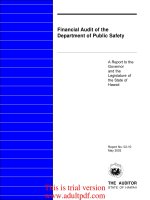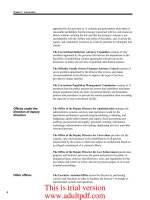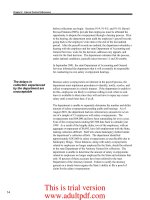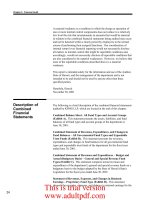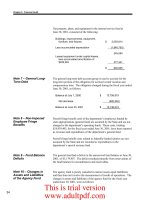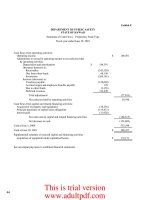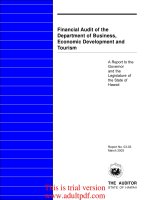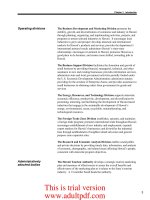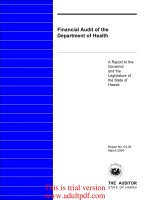financial audit of the department of public safety_part1 ppt
Bạn đang xem bản rút gọn của tài liệu. Xem và tải ngay bản đầy đủ của tài liệu tại đây (187.04 KB, 10 trang )
Financial Audit of the
Department of Public Safety
A Report to the
Governor
and the
Legislature of
the State of
Hawai‘i
THE AUDITOR
STATE OF HAWAI‘I
Report No. 06-05
August 2006
This is trial version
www.adultpdf.com
Office of the Auditor
The missions of the Office of the Auditor are assigned by the Hawai‘i State Constitution
(Article VII, Section 10). The primary mission is to conduct post audits of the transactions,
accounts, programs, and performance of public agencies. A supplemental mission is to
conduct such other investigations and prepare such additional reports as may be directed
by the Legislature.
Under its assigned missions, the office conducts the following types of examinations:
1. Financial audits attest to the fairness of the financial statements of agencies. They
examine the adequacy of the financial records and accounting and internal controls,
and they determine the legality and propriety of expenditures.
2. Management audits, which are also referred to as performance audits, examine the
effectiveness of programs or the efficiency of agencies or both. These audits are also
called program audits, when they focus on whether programs are attaining the
objectives and results expected of them, and operations audits, when they examine
how well agencies are organized and managed and how efficiently they acquire and
utilize resources.
3. Sunset evaluations evaluate new professional and occupational licensing programs to
determine whether the programs should be terminated, continued, or modified. These
evaluations are conducted in accordance with criteria established by statute.
4. Sunrise analyses are similar to sunset evaluations, but they apply to proposed rather
than existing regulatory programs. Before a new professional and occupational
licensing program can be enacted, the statutes require that the measure be analyzed
by the Office of the Auditor as to its probable effects.
5. Health insurance analyses examine bills that propose to mandate certain health
insurance benefits. Such bills cannot be enacted unless they are referred to the Office
of the Auditor for an assessment of the social and financial impact of the proposed
measure.
6. Analyses of proposed special funds and existing trust and revolving funds determine if
proposals to establish these funds are existing funds meet legislative criteria.
7. Procurement compliance audits and other procurement-related monitoring assist the
Legislature in overseeing government procurement practices.
8. Fiscal accountability reports analyze expenditures by the state Department of
Education in various areas.
9. Special studies respond to requests from both houses of the Legislature. The studies
usually address specific problems for which the Legislature is seeking solutions.
Hawai‘i’s laws provide the Auditor with broad powers to examine all books, records, files,
papers, and documents and all financial affairs of every agency. The Auditor also has the
authority to summon persons to produce records and to question persons under oath.
However, the Office of the Auditor exercises no control function, and its authority is limited
to reviewing, evaluating, and reporting on its findings and recommendations to the
Legislature and the Governor.
THE AUDITOR
STATE OF HAWAI‘I
Kekuanao‘a Building
465 S. King Street, Room 500
Honolulu, Hawai‘i 96813
This is trial version
www.adultpdf.com
The Auditor State of Hawai‘i
OVERVIEW
Financial Audit of the Department of Public Safety
Report No. 06-05, August 2006
Summary
The Office of the Auditor and the certified public accounting firm of KPMG LLP
conducted a financial audit of the Department of Public Safety, State of Hawaiÿi,
for the fiscal year July 1, 2004 to June 30, 2005. The audit examined the financial
records and transactions of the department; reviewed the related systems of
accounting and internal controls; and tested transactions, systems, and procedures
for compliance with laws and regulations.
In the opinion of the firm, the financial statements present fairly, in all material
respects, the department’s financial position and changes in its financial position
for the fiscal year ended June 30, 2005, in conformity with generally accepted
accounting principles.
With respect to the department’s internal control over financial reporting and
operations, we found several deficiencies considered to be reportable conditions.
The first reportable condition is that the department is not fulfilling its fiduciary
responsibility to the inmates. The department continues to have difficulties in both
reconciling and transferring inmate trust account balances accurately and timely.
For example, the total gross unreconciled difference between the Inmate Trust
Accounting system and bank balances for all correctional facilities and community
correctional centers was $129,779 as of June 30, 2005. Also, the controls over
advances to inmates need improving. We found that advances were made for
unallowable purposes and advances for inactive inmates are not monitored and
collected. Additionally, although there have been significant improvements,
proper remittance of unclaimed or inactive inmate accounts continues to be
problematic for the department.
Our second reportable condition is that ineffective internal controls allow significant
overtime to remain unchecked. Although vacancies and potential staffing limitations
may contribute to the inherency of some overtime costs, current policies and
procedures are ineffective at limiting those costs. For example, the policies and
procedures allowed an employee to be paid two years after the work was
performed. Additionally, uninhibited sick leave usage continues to increase
overtime costs.
We also found that although the collection of salary overpayments has improved
significantly, uncollected balances remain. Enhancements in the collection
process for recent staff overpayments have helped reduce the balances, but the
department must continue its efforts to eliminate the remaining uncollected
balances.
Finally, we found that the department’s adherence to its operational internal
controls and procedures needs improving. Specifically, we found two instances
This is trial version
www.adultpdf.com
Report No. 06-05 August 2006
Marion M. Higa Office of the Auditor
State Auditor 465 South King Street, Room 500
State of Hawai‘i Honolulu, Hawai‘i 96813
(808) 587-0800
FAX (808) 587-0830
in which the department did not comply with the state procurement code. We also
found that its capital assets inventory listing was inaccurate and resulted in a
restatement of the department’s beginning net assets in the basic financial
statements totaling approximately $4.3 million, net of related accumulated
depreciation.
We recommend that the department’s business offices immediately reconcile
inmate trust accounts to bank balances and the department advise each facility to
comply with its policies as they pertain to the inmate fund transfers between
facilities. The department should reiterate the importance of adherence to
established policies related to inactive inmate accounts and advances and should
also develop and implement policies and procedures over inactive suspense
accounts.
We also recommend that the department’s management consider the following to
address significant overtime: establish more specific criteria for determining when
overtime is necessary; focus efforts on preventing overtime costs; prepare exception
reports; monitor the equitable allocation of overtime; ensure that the request and
timesheet for overtime work is completed and approved in a timely manner; and
revise policies. The department should also consider the following recommendations
to address potential sick leave abuse: work with the bargaining units to implement
a more stringent policy for determining patterns of sick leave abuse; implement
realistic deadlines to complete sick leave abuse reviews; and consider automating
leave records to facilitate detection of sick leave abuse patterns.
We further recommend that the department’s management continue to perform
timely audits of salary overpayments and reduce the backlog of pending audits.
The department should also take action to reconcile discrepancies between
bargaining agreements and state statutes to reduce delays in scheduling hearing
dates. The department should also consider contracting out the salary collection
process in order to expedite the process further.
Finally, we recommend that the department adhere to the state procurement code
pertaining to small purchases. Also, the department’s management should instruct
facilities to accurately conduct annual physical inventory and reconcile it to the
State’s capital asset inventory listing.
In its written response to our draft report, the department agrees with many of our
findings and recommendations while strongly disagreeing with our comments and
characterizations regarding overtime. However, we stand by our conclusions in
the final report and believe our audit report presents a balanced and accurate
analysis of the department’s financial operations.
Recommendations
and Response
This is trial version
www.adultpdf.com
Financial Audit of the
Department of Public Safety
Report No. 06-05
August 2006
A Report to the
Governor
and the
Legislature of
the State of
Hawai‘i
Conducted by
The Auditor
State of Hawai‘i
and
KPMG LLP
THE AUDITOR
STATE OF HAWAI‘I
Submitted by
This is trial version
www.adultpdf.com
Foreword
This is a report of the financial audit of the Department of Public Safety,
State of Hawaiÿi, for the fiscal year July 1, 2004 to June 30, 2005. The
audit was conducted pursuant to Section 23-4, Hawaiÿi Revised Statutes,
which requires the State Auditor to conduct postaudits of all departments,
offices, and agencies of the State and its political subdivisions. The audit
was conducted by the Office of the Auditor and the certified public
accounting firm of KPMG LLP.
We wish to express our appreciation for the cooperation and assistance
extended by the officials and staff of the Department of Public Safety.
Marion M. Higa
State Auditor
This is trial version
www.adultpdf.com
v
Table of Contents
Chapter 1 Introduction
Background 1
Organization 2
Objectives of the Audit 5
Scope and Methodology 6
Chapter 2 Internal Control Deficiencies
Summary of Findings 7
The Department Is Not Fulfilling Its Fiduciary
Responsibilities to the Inmates 8
Recommendations 13
Ineffective Internal Controls Allow Significant
Overtime to Remain Unchecked 14
Recommendations 24
Although the Collection of Salary Overpayments
Has Improved Significantly, Uncollected
Balances Remain 25
Recommendations 28
Adherence to Operational Internal Controls and
Procedures Needs Improving 28
Recommendations 30
Chapter 3 Financial Audit
Summary of Findings 31
Independent Auditors’ Report 31
Report on Internal Control over Financial Reporting
and on Compliance and Other Matters Based on an
Audit of Financial Statements Performed in
Accordance with Government Auditing
Standards 33
Description of Basic Financial Statements 35
Notes to Basic Financial Statements 36
Response of the Affected Agency 73
This is trial version
www.adultpdf.com
vi
List of Exhibits
Exhibit 1.1 Hawaiÿi’s Correctional Facilities and Community
Correctional Centers 2
Exhibit 1.2 Organizational Structure of the Department of
Public Safety 3
Exhibit 2.1 ITA System Balances, Bank Reconciliation Balances,
and Differences Between the Balances for Each
Facility as of June 30, 2005 9
Exhibit 2.2 Three-year Trend Analysis of Total Overtime Costs
Compared to Salaries and Wages by Facility
(amounts in thousands) 15
Exhibit 2.3 Detail of Base Compensation and Overtime
Compensation for Four Employees at the Hälawa
Correctional Facility 18
Exhibit 2.4 Sick Leave Taken, Average Sick Leave Taken per
Uniform Staff Overtime Hours Incurred, and
Average Overtime per Uniform Staff by Facility
for the Fiscal Year Ending June 30, 2005 21
Exhibit 2.5 Overtime Hours Incurred by Uniform Staff,
Overtime Attributed to Sick Leave Taken by
Uniform Staff, and Overtime Attributed to Sick
Leave as a Percentage of Total Overtime Hours
by Facility for the Fiscal Year Ending
June 30, 2005 22
Exhibit 2.6 Discrepancies and Financial Statement Effect of
Employee Leave Records for Four Employees
at the Oÿahu Community Correctional Center 24
Exhibit 3.1 Management’s Discussion and Analysis,
June 30, 2005 55
Exhibit 3.2 Statement of Net Assets, June 30, 2005 62
Exhibit 3.3 Statement of Activities, Year ended
June 30, 2005 63
Exhibit 3.4 Government Funds Balance Sheet, June 30, 2005 64
Exhibit 3.5 Reconciliation of the Governmental Funds
Balance Sheet to the Statement of Net Assets,
June 30, 2005 65
Exhibit 3.6 Government Funds Statement of Revenues,
Expenditures, and Changes in Fund Balances,
Year ended June 30, 2005 66
Exhibit 3.7 Reconciliation of the Governmental Funds Statement
of Revenues, Expenditures, and Changes in Fund
Balances to the Statement of Activities, Year
ended June 30, 2005 67
Exhibit 3.8 General Fund Statement of Revenues and
Expenditures - Budget and Actual (Budgetary
Basis), Year ended June 30, 2005 68
This is trial version
www.adultpdf.com
vii
Exhibit 3.9 Proprietary Fund Statement of Net Assets,
June 30, 2005 69
Exhibit 3.10 Proprietary Fund Statement of Revenues, Expenses,
and Change in Fund Net Assets, Year ended
June 30, 2005 70
Exhibit 3.11 Proprietary Fund Statement of Cash Flows, Year
ended June 30, 2005 71
Exhibit 3.12 Agency Fund Statement of Assets and Liabilities,
June 30, 2005 72
This is trial version
www.adultpdf.com
1
Chapter 1: Introduction
Chapter 1
Introduction
This is a report of our financial audit of the Department of Public Safety,
State of Hawaiÿi. The audit was conducted by the Office of the Auditor
and the independent certified public accounting firm of KPMG LLP.
The audit was conducted pursuant to Section 23-4, Hawaiÿi Revised
Statutes (HRS), which requires the State Auditor to conduct postaudits of
the transactions, accounts, programs, and performance of all
departments, offices, and agencies of the State of Hawaiÿi and its
political subdivisions.
The department is responsible for: providing for the custody, care, and
assistance in the rehabilitation of all persons incarcerated by the courts or
otherwise subject to confinement based on commitment or an alleged
commitment of a criminal offense; guarding state property and facilities;
preserving peace and protecting the public in designated areas; enforcing
specified laws, rules, and regulations for the prevention of crime; and
serving process papers in civil and criminal proceedings. Section 26-
14.6, HRS, further describes the department’s responsibilities.
The department shall be responsible for the formulation and
implementation of state policies and objectives for correctional, security,
law enforcement, and public safety programs and functions; the
administration and maintenance of all public or private correctional
facilities and services; the monitoring of contracted private correctional
facilities and services; provision of law enforcement services at the
Honolulu International Airport; and the security of state buildings.
The department manages the State’s four correctional facilities (prisons)
and four community correctional centers (jails). Exhibit l.l identifies the
location and number of inmates in the State’s correctional facilities and
community correctional centers.
Background
This is trial version
www.adultpdf.com
